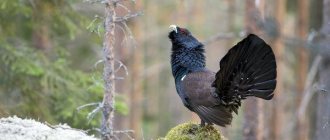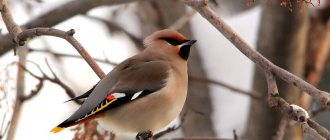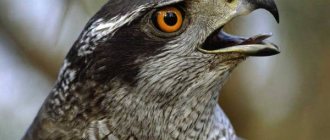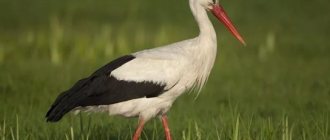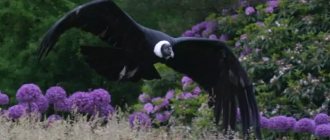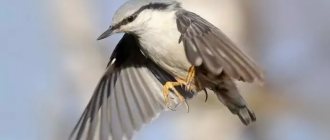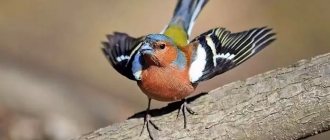Description of the bird
Small songbirds from the finch family - bullfinches - are called Pyrrhula in Latin, which translates as “fiery”, and indicates the bright special color of their plumage.
The genus includes 9 species and is divided into two subgroups: masked and black-capped bullfinches. In masked birds, black feathers around the beak create a kind of “mask”; in black-capped birds, it is on the back of the head.
— Advertising —
The size of these birds is small - up to 15 cm in length, with a wingspan of up to 25 cm and a weight of about 35 g.
What does it eat?
The bullfinch eats frozen berries.
The bullfinch is unpretentious in nutrition. Its main food consists of seeds and berries, from which birds eat them, leaving pulp, as well as insects. If you ask yourself what do bullfinches like or what do they feast on, the answer is: the color of oak trees, willow catkins, dandelions, nettles, blackberries, sorrel. In addition, in winter the bullfinch eats rowan berries, which is an unforgettable sight.
Young bullfinches are also fed plant foods, to which insects and spiders are added.
Nutrition
The main thing for bullfinches is plant food. These are mainly seeds of trees and shrubs. Their favorite delicacy is berries. Bullfinches on mountain ash are a fairly common occurrence.
The interesting thing is that they do not completely eat the rowan fruits. Those who are more observant can remember how exactly under this tree there are many torn berries. This is the work of bullfinches. They take out the seeds from the pulp, feast on them, and simply throw away everything else.
Birds do not refuse buds, tree shoots, and flowers. They are indifferent to insects and only occasionally treat themselves to such food. These birds have no boundaries when it comes to food. They can peck at something endlessly, which affects their weight.
All flights and travels of bullfinches are associated with the availability of food. If food is abundant, they can stay in the same place for a long time. When paired with babies that have already been born, the female takes on all the responsibility for finding food. The male is busy with the chicks at this time.
Where does it live?
— Advertising —
Pyrrhula pyrrhula range
Bullfinches live in coniferous forests, forest-steppe and forest-tundra throughout Eurasia. They inhabit both lowland and mountainous areas, but like to settle in forests. Bullfinches are not afraid of people, so they can often be found in gardens and parks. In addition, deforestation and destruction of their natural habitat contributes to the relocation of bullfinches closer to humans.
Where do they live in the summer?
Photo of a bullfinch, in summer
Bullfinches live in coniferous highland and lowland forests in summer, avoiding treeless areas. On the territory of Russia, the bird lives in the forest and forest-steppe zones. In summer, birds hide in the crowns of trees and feed on coniferous tree buds, berries, and seeds.
Spreading
It is believed that bullfinches are forest birds. The bullfinch's habitat is predominantly mixed and coniferous forests of Asia and Europe from the Atlantic to the Pacific Ocean. Nevertheless, bullfinches are often found in city parks and in the courtyards of residential buildings; they are guests in small feeders outside the windows of multi-story buildings, and on children's playgrounds. But this does not mean at all that bullfinches can be classified as city dwellers. It’s just that these red-breasted birds fly to the city to eat and refresh themselves.
Kinds
Common bullfinch
This is what a male bullfinch looks like.
This bird is the size of a sparrow. The plumage on the crown, around the eyes and beak is black. The wings are also black with a blue sheen. The back is gray with a whitish loin. And the belly, sides, cheeks and chest in males are intense red, in females they are grayish-brown. The chicks are colored in various shades of brown and do not have a black cap of feathers on their heads.
The habitat is very wide - Europe, Central and East Asia, including Japan, Kamchatka and Siberia.
Azores bullfinch
In the photo, the Azores bullfinch is sitting on a branch.
It lives only on the island of Sao Miguel (Azores) and is an endangered species. The plumage of the Azorean bullfinch is chocolate brown, with red spots on the sides. In summer the color becomes lighter. On the bird's head, black feathers form a “cap”; the chin and beak are also black. The chest and belly are brown. The species is larger in size than the common bullfinch (up to 17 cm in length). There is no sexual dimorphism.
White-cheeked bullfinch
White-cheeked Bullfinch eats a tree bud
An inhabitant of the high-mountain coniferous forests of the Philippine archipelago and the southernmost tropical species of Black-capped Bullfinches. The plumage is mostly brown with pure white cheeks and white patches on the sides. Females and males are no different.
Brown bullfinch
Photo of a brown bullfinch on a branch.
It belongs to the group of masked bullfinches and lives in the mountain coniferous forests of Indochina, South Asia, and Taiwan.
The plumage is very similar to an ordinary bullfinch with only one difference - the tummy, chest and cheeks of the brown bullfinch are brown. That is why females and males of this species are practically indistinguishable from each other.
Yellow-backed Bullfinch
Yellow-backed bullfinch - photo
It is found in the forests of the Western Himalayas (India and Pakistan) in a very limited area, which is why it is considered an endangered species.
The yellow-backed bullfinch is a small masked bullfinch with a predominant orange-ochre tinge in its plumage. Males are brighter than females, especially in the dorsal and crown areas. Females are gray-brown in color.
Red-headed Bullfinch
Red-headed Bullfinch on a branch
This species is a small, colorful masked inhabitant of the Himalayas. Its size is slightly smaller than a sparrow. The wings are black with a red spot, the back is gray. The head, chest and abdomen of the male are orange-red; in females they are yellow.
Grey-headed Bullfinch
The gray-headed bullfinch feeds.
It belongs to the group of masked bullfinches. The plumage is predominantly gray with a bright orange belly, decorated with red spots in males. Females are modest - with a gray-brown chest and abdomen.
The grey-headed bullfinch is widely distributed from the Western Himalayas to the north and east of China.
Gray bullfinch
Gray bullfinch photo in winter
An inhabitant of Siberia and the Far East, the plumage of which lacks red. Dimensions: slightly smaller than the common bullfinch. The plumage on the top of the head, around the beak and eyes is black. The wings are black with a blue metallic sheen. The loin and undertail area are painted white.
Ussuri bullfinch
Ussuri bullfinch in eastern Russia
One of the smallest bullfinches, lives in the Far East, Sakhalin, the Japanese and Kuril Islands. The species belongs to the black-capped bullfinches. The cheeks and throat of the male are intensely colored red-orange. The abdomen is gray with a pink tint. The female is lighter than the male, with a predominance of brown shades in the plumage.
Reproduction
The description of the bullfinch during the mating season is interesting. The voice of male bullfinches becomes more melodic, it sounds much more pleasant than usual. They dedicate their trills to their lovely chosen ones, and they respond with quiet, muffled whistling.
Pairs form in flocks in March. In any family of these bright birds, matriarchy reigns; the main role here lies with the females.
What does a male and female look like?
Differences between female and male bullfinch - visual drawing
Sexual dimorphism of the bullfinch varies depending on the species. The female and male are easily distinguished from each other by the color on the chest and the difference in plumage. Young animals, before the first autumn moult, differ from adult birds in the brightness of the color of their plumage. Males and females do not differ in size.
Male
The color of the male bullfinch depends on the species. The Common, Grey-headed and Red-headed bullfinch are identified by their reddish-pink belly and sides. Male yellow-backed bullfinches are orange in color, especially on the back and crown. In other species, males are brighter than females.
Female
In bullfinches, the color of females is very different from males. Females of the common, yellow-backed and grey-headed bullfinch have grayish-brown plumage and, unlike males, are not colored with a red belly and red sides. Female red-headed bullfinch have a yellow abdomen. In Usuri bullfinches, the female is lighter than the male.
In some cities of the CIS there is an interesting name for the female bullfinch; she is called “Snegirka”, but this name is not correct. The female bullfinch is called “Female Bullfinch”, there is no other name.
How to distinguish a female from a male
The difference between male and female bullfinch is in color and plumage. To distinguish a female common, yellow-backed or gray-headed bullfinch, we look at the abdomen; in females it is grayish-brown. Males of Usuri bullfinches are darker than females; females also have brown shades in their plumage. Sexual dimorphism is weakly expressed in White-cheeked, Brown and Azorean bullfinches; males and females differ slightly from each other.
Popular message topics
- Life and work of Karamzin In addition to the fact that Nikolai Karamzin is an outstanding historian and writer, he is also credited with a significant contribution to the development of Russian language reforms. The most significant works include “History of the Russian State” and “Poor Liza”.
- Nobles in ancient Egypt Egypt has kept many secrets to this day. A state that has a rich history, which historians and scientists are still trying to understand. This state has always adhered to a model of government in which the ruler had absolute influence
- Still life (in painting) Still life in painting is an image of various objects that must be combined with each other. A still life is most often one unique creation, but can also be part of one large composition.
Efa snake. description, features, types, habitat and lifestyle of efa
Keeping at home
Bullfinches in a cage - photo
At first, the bird may fight and be afraid of people. But the bullfinch quickly masters and gets used to humans.
Requirements for the cage (aviary)
To keep a bullfinch you will need a spacious cage with perches. To stimulate nesting, spruce branches are secured in the corner of the cage as a shelter. In one clutch the female has up to 7 small eggs, which she incubates for two weeks. The chicks grow up in about 15-19 days.
What to feed
The bullfinch is unpretentious in nutrition. It can be fed with grass seeds, small grains, birch and pine buds, rowan berries, bird cherry, and juniper. They also give the bird fruits and greens, twigs of cherry, pine, birch, willow, apple trees, viburnum and their fresh bark. In spring and summer, the diet is enriched with eggshells, chalk, clay and animal food (grasshoppers, mealworms).
In captivity, bullfinches live 10-12 years.
Behavior
Ornithologists observe the behavior of these beautiful birds during their migrations, when they fly south - to Transbaikalia, the Amur basin, Crimea, Central Asia and North Africa. Descriptions of bullfinches in various publications characterize them as calm, leisurely and balanced birds. But at the same time they are quite cautious and careful. In the presence of humans, bullfinches are not very active and most often behave very warily, especially for females.
In a flock of bullfinches there are almost never open confrontations and disagreements. Red-breasted birds live quite amicably and peacefully. Females rarely show aggression. At the same time, they make characteristic sounds with their beaks and quickly rotate their heads. But this happens extremely rarely and only when there is an objective reason.
If a person decides to feed the birds and leaves them a treat, then they will not refuse the treat and will be happy to eat.
Interesting Facts
The bullfinch flew up to take the seed
- Bullfinches are very beautiful, and also very calm birds; they never rush or fuss.
- Bullfinches eat buds and shoots of fruit trees, which is why gardeners do not like them;
- The favorite delicacy of bullfinches is ash seeds. Since ash trees bear fruit only once every two years, we can guess when bullfinches will raid the gardens.
Natural enemies of bullfinches
Bullfinches have many natural enemies, especially since this is helped by the bright colors of the birds, as well as their sluggishness and slowness.
Natural enemies of bullfinches can be considered:
- Sparrowhawk.
- Marten.
- Owl.
- A cat, both wild and domestic.
When bullfinches feed as part of a flock, they become especially noticeable to their enemies. In addition, the birds lose their vigilance. The situation is further aggravated by the fact that bullfinches cannot be called birds with high flight characteristics. They are slow in the air and rarely manage to escape the pursuit of predators.
Interesting moment! For greater safety, bullfinches often join flocks of greenfinches, finches or thrushes. At the first alarming cries of a thrush, bullfinches try to immediately leave the dangerous place.


